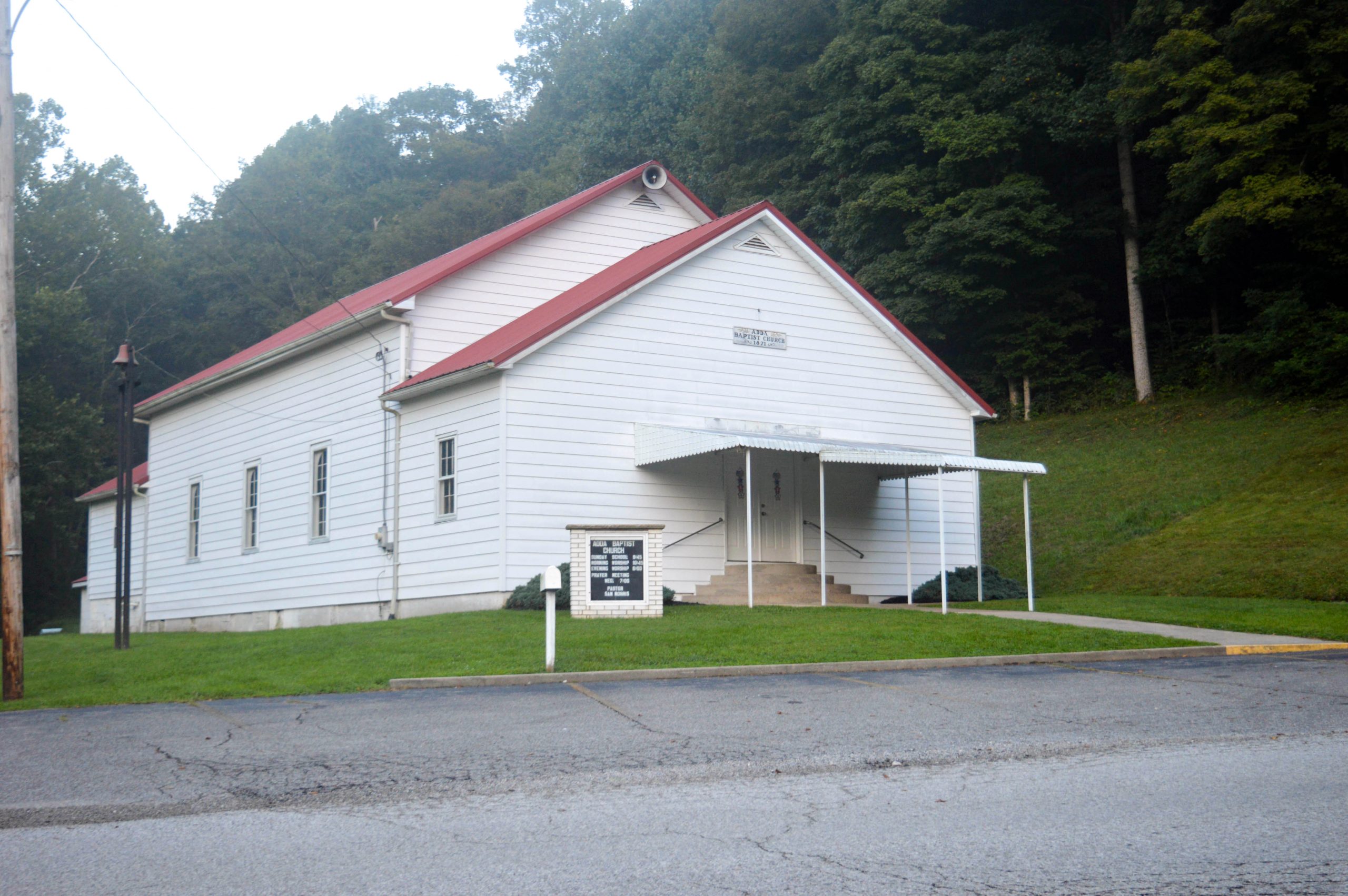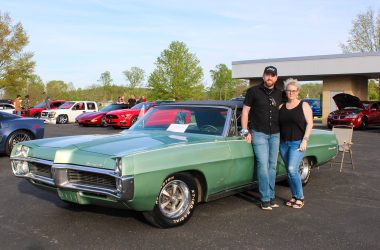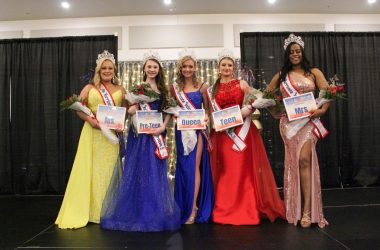Editor’s Note:
In January of 1985, Wanda Hodges Gibson compiled a church history for Adda Baptist Church dating from 1871 to 1985. In recognition of Adda’s 150th birthday celebration the Breeze is publishing Wanda Gibson’s 1985 history. Adda Baptist Church celebrated its 150th anniversary with special homecoming services on August 21 and 22, 2021. The first installment follows:
The official date of organization of the Adda Baptist Church is 1871. It is believed that 1871 was the year in which the second log church was built near the waters of Poplar Fork, a tributary of Big Hurricane Creek. The second log church was built where Chalmer Grant’s yard is now located. However, the roots of the church were formed many years earlier. We understand that the first church was located where the late Harvey Gibson lived, and his wife, Ruth Gibson, now resides. The farm was then owned by John T. Harbor, one of the community’s first settlers. Mr. Harbor built and operated the old grist mill at his farm, which is still known as the “Mill Dam.” For those of you who do not know where this is, it is located a few yards above the bridge going across to Mrs. Lillard Gibson’s, where we have held several baptisms lately.
The logs for the first church were cut from Mr. Harbor’s farm, and the building of the church was a community project. Some of the organizers and leaders of the old log church were: John Erwin, Bill Gibson, Peter Gillispie, John T. Harbor, Lewis Hodges, Joseph Holley, Davis Jones, Lewis McGuire, Ike Meadows, Charley Qualls, and others whom we may have failed to mention. Of course, the families of these men were also active in the smooth operation and organization of the old church, and they formed the congregation thereof. It is believed that our church was named after Adda Crowder Harbor, the wife of John T. Harbor. Since she became the first member of the church, it is very likely that the little log church built on Mr. Harbor’s farm was also named Adda.
As Hurricane Creek Road was becoming well populated and the church was small, some members felt they needed another church. So Bethel came into being. Bethel was built in 1869. Many new families had moved into the community, and it is believed that since Bethel and Adda were comparatively close, it would be a good idea to move the Adda location to accommodate more families. The community as spreading out in an ever-widening circle, so the second log church named Adda was built a few miles down the road.
People from miles around came to church on foot, horseback, in wagons or buggies. In suitable weather, Adda and Bethel would join together to have singing meetings, outdoor revivals, and other gatherings. In some instances, the two churches would hire the same pastor and would conduct services on alternating Sundays. In the records, I found only one Pastor recorded to have served both churches at the same time: Rev. Donald Taylor, 1946-1949.
Life in those days was beautifully simple, though dreadfully complex in some ways. “Everyone had plenty to eat, good homemade clothing to wear, and they were not over-burdened with debts.” With the absences of convinces of any kind, life itself had to be maintained through hard work, little or no finances, good management, and plenty of good old-fashioned faith. Yet everyone had time to be friendly, to visit, to help a sick neighbor, and enter into work-sharing, community, or church projects. The problems of one family would be the problems of all, as each family was dependent upon their neighbors for help in time of trouble, as well as for Christian fellowship. Yet, without all the conveniences they still had time to go to church to worship. There were many hard working hours put into the building of this church. To the people back in those days, life was hard and money was scarce, but they had more time for the Lord than we now seem to with all the modern conveniences.
The second log church was used for about two decades and was constantly increasing in membership and community importance. It is possible that either the congregation outgrew the building or the members desired to build a more beautiful church in which to worship their Master. In any event, plans were put into action shortly before the turn of the century to build the present Adda Baptist Church.
Huge, virgin, yellow poplar trees furnished the logs since poplar was the favorite building material in that day. It was sturdy, strong, and able to withstand the test of times. The seats were also handmade of poplar and were used at the church until 1958. Most of the old seats were then given to the Springdale Pentecostal Church of God on Cow Creek Road.
The logs were from the Peter and Jane Hodges farm near the church, where they were sawed by Mr. Hodges at his saw mill on the church grounds. The lumber was then ricked on posts and firecured. Mr. Jule Erwin hand-dressed the lumber, and the church building was on its way to completion.
Wesley Wyant was contracted as the carpenter to build the church. However, with everyone in the community sharing the work and financing, the building was completed in a short time. There was no necessity of a building fund, since the project was community wide in scope and interest. It was built by the good spirit and faith of the whole neighborhood.
Through the years, there’s always been an abundance of Christian individuals ready to cooperate in the running and operation of Adda Church. There have been those whose names are synonymous with the continued growth of the church. To think of Adda Church is to think of such individuals and families as Ira, Jule, Lewis and Pearl Erwin; Ben and Joseph Holley; Willy and A. D. Billups; Billy, Charley, Elzie, Johnny, Lewis, Peter, Frank, Vincent and Stephen Hodges; Clarence and Leo Moses; Johnny Crowder; J. M. Young; Mitchells; Johnsons; Meedings, Scarberrys; Meeks; Grants; Gibsons; Birds; McDowells; Smiths; Taylors; Calls; Sowards; Meadows; Disneys; and many, many more. For instance, one lady by the name of Malinda Meeks, who lived in Winfield, rode a horse to every meeting – summer, winter, rain or snow. She attended businesses meetings and was active in all other church activities. It took hard working men and women to build our church, but much more important, it took men and women who were close to God in their spiritual life to make this building a place in which to worship. It was people like Melinda, who had faith in God, that kept and still keeps the doors of Adda open for the worship of our Master.
The records of the church, from 1871 to 1908 were destroyed by fire in the home of Mr. Lewis Erwin, who was clerk of Adda in 1908. He only knowledge we have was received from the few older members that went to Adda when they were children. As we look back on the records that we do have, we find many interesting things. To those people it was a God sent miracle to be able to have a church and to pay off the debts.
In 1909, roofing was bought from Montgomery and Ward Co. for $2.95 a square. Lumber and nails for the roof cost $5.15. After taking the old roofing off, it was sold to the highest bidder for $10.00. Of course, with a new roof, they needed a paint job on the inside, so $8.75 was collected. In the summer of 1910 the paint was bought off Peter Hodges for $8.00. M. F. Mitchell reported he had gotten the window glass for the church for 50¢ in April 1909. All this took place after the finance committee had reported that they had only $3.25 in the treasury in September of 1908.
We understand from the minutes that the members of the church would meet to access themselves on what they were able to give on a given job or for the salary of the pastor. If enough money wasn’t available, they would solicit from those members not attending. They voted in February 1946 to stop solicitation of funds.
In November 1910, they began talking about purchasing lamps for the church. They elected a committee including Brothers C. E. Moses and Charley Hodges, Sisters Malinda Meeks and Mary J. Erwin, with Sister Effie Crowder taking the place of Mary J. Erwin a few months later. In June, 1911 the committee was released after collecting $21.50. Two years later in December 1913, they finally purchased the lamps for $13.00. In 1914, they paid 60¢ for three gallons of kerosene to use these lamps.
In June 1912, they paid $1.05 for 15 bushels of coal. Eight years later, they paid $2.25 for the same amount. They purchased a service flag in December 1918 for $1.00. It was in April 1976 when the Men’s Class purchased the American and Christian flags that now stand on the podium in our sanctuary. They cost a total of $145.00.
The Senior Class purchased new offering plates and Bible stand for the Communion table in October 1974. Charles Ebert made them for us. The Senior Class also purchased the shrubbery out front of our church. The Primary Class has since purchased the silver bread Communion plates. There are always projects being donated by different classes to improve our church. Like the one in late 1984 when the Jr. High class paid to have our walk repaired with some of the men of the church doing the labor. If I have failed to mention any project it is unintentional.
As you know, Adda Baptist Church is a Missionary Baptist Church. Even in the earliest records we find that the church paid into the missions. In 1909, the church paid $2.00 a year to missions; in 1924, $50.00; and in 1928, the quota was set for $60.00, but they could only pay $40.00. In 1933, the quota was set for $35.00. In the minutes on February 17, 1934 it stated, “Our church is behind in its quota for missions for the past year,” but yet, when another church (Lumberport Baptist Church, Lumberport, WV) was in debt, Adda sent in a donation of $1.00 to help pay their debt. This is what you call faith. In 1947, the quota was raised to $100.00. In 1949, $150.00; in 1953, $200; in 1959, we raised it to $400.00. We are currently paying $540.00 a year.
The records show that in October 1968, “The church pledged itself to contribute $612.00 to the mission campaign. The church designated this money to be used for West Virginia Missionaries and no portion was to go to National or World Council of Churches.” In November 1983, “Discussion was held concerning having a letter prepared and sent to the West Virginia Baptist Convention stating that Adda Baptist Church does not support in any way whatsoever the National or World Council of Churches. It was mentioned and seconded that Preacher Curry draft a letter stating the position of our church in order that Adda Baptist will be on record as not supporting either the National or World Council of Churches. The motion was carried.” In the December 1983 minutes, it states, “Rev. Curry had sent a letter to the American Baptist Association indicating our position, and that the Church Clerk would be receiving a letter in this regard.” In May 1984 business meeting the minutes state, “the clerk had received the forms requested from the American Baptist Churches, U.S.A., but in order to complete the form a formal motion reflecting the church’s opposition to the National and World Council of churches had to be entertained. It was motioned and seconded that Adda Baptist Church go on record as not approving affiliation with or providing financial support to the National Council or World Council of Churches through the American Baptist Churches, retroactive to November 1983. The motion was carried unanimously.”




